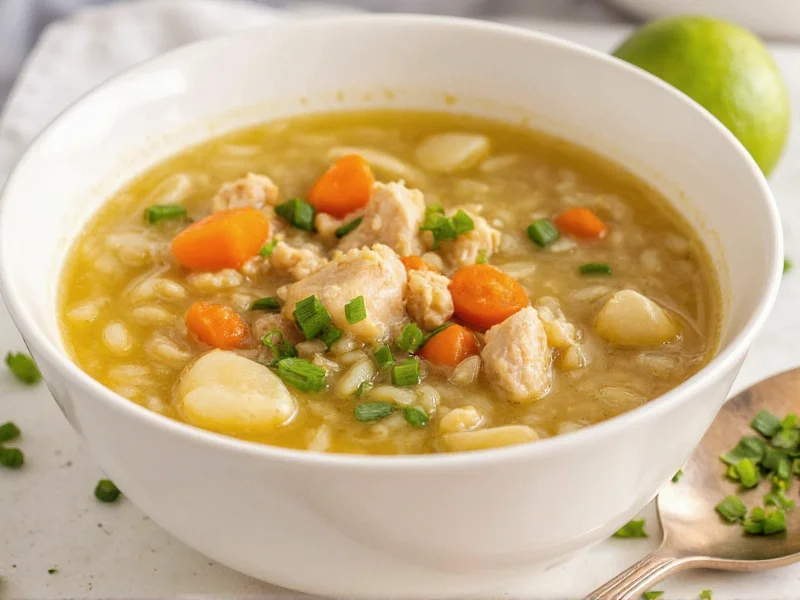Why This Chicken Rice Soup Recipe Works
Homemade chicken rice soup stands apart from store-bought versions through its depth of flavor and comforting texture. Unlike canned alternatives, a properly made version features tender chicken, perfectly cooked rice, and a clear broth that carries the essence of carefully selected ingredients. The magic happens when you take time to build flavors layer by layer rather than rushing the process.
Essential Components of Perfect Chicken Rice Soup
Creating exceptional homemade chicken rice soup requires attention to three critical elements: broth quality, rice texture, and ingredient balance. Many home cooks make the mistake of using pre-cooked chicken and instant rice, which results in bland flavor and mushy texture. Instead, start with raw chicken pieces to extract maximum flavor during simmering.
| Ingredient | Quantity | Preparation Notes |
|---|---|---|
| Bone-in chicken thighs | 1.5 lbs (680g) | Provides richer flavor than breast meat |
| Long-grain white rice | 1/2 cup (90g) | Rinsed thoroughly to prevent cloudiness |
| Yellow onion | 1 medium | Diced small for even flavor distribution |
| Carrots | 2 medium | Cut into 1/4-inch rounds |
| Celery stalks | 2 medium | Finely diced |
| Garlic cloves | 3 | Minced |
| Chicken broth | 6 cups (1.4L) | Low-sodium preferred |
| Fresh parsley | 3 tbsp | Chopped, for garnish |
Step-by-Step Cooking Process
Begin by placing chicken thighs in a large pot with 4 cups of cold water. Bring to a gentle simmer over medium heat—never a rolling boil, which makes chicken tough. Skim off any foam that rises to the surface during the first 10 minutes. After 20 minutes of gentle simmering, remove chicken and set aside to cool slightly while you prepare the vegetables.
While chicken simmers, sauté onions, carrots, and celery in olive oil until softened but not browned—about 8 minutes. Add garlic and cook for 1 additional minute until fragrant. This technique, called sweating, develops flavor without caramelization that would alter the soup's delicate profile.
Return the chicken (now deboned and shredded) to the pot along with the sautéed vegetables, remaining broth, and rinsed rice. Simmer uncovered for 15-18 minutes until rice reaches al dente texture. Overcooking rice causes it to break down and thicken the broth undesirably. Stir in fresh lemon juice just before serving to brighten flavors.
Professional Tips for Exceptional Results
Seasoning properly makes the difference between good and great homemade chicken rice soup. Add salt in three stages: a pinch to the cooking water for chicken, another pinch to the vegetables while sautéing, and final adjustments after combining all ingredients. This layered approach creates balanced flavor throughout.
For gluten-free homemade chicken soup with rice that's perfect when sick, ensure your broth is certified gluten-free and avoid adding flour-based thickeners. The natural gelatin from simmering chicken bones creates a satisfying mouthfeel without needing thickeners.
When making chicken and rice soup for meal prep, cook the rice separately and add it to individual portions when reheating. This prevents the rice from becoming mushy during storage. Properly stored in airtight containers, the soup base keeps for 4 days in the refrigerator or 3 months frozen.
Variations for Dietary Needs
For a keto-friendly version of comforting soup without rice, substitute cauliflower rice added during the last 5 minutes of cooking. Those seeking extra protein can add a beaten egg stirred slowly into the hot broth off-heat, creating delicate ribbons—a technique borrowed from traditional Chinese egg drop soup.
When preparing easy homemade chicken rice soup for babies, omit salt entirely and ensure all ingredients are thoroughly cooked and finely chopped. Pediatricians often recommend this simple version for infants transitioning to solid foods.
Frequently Asked Questions
How do you prevent rice from getting mushy in chicken soup?
Rinse rice thoroughly before adding to remove excess starch, add it during the last 15-18 minutes of cooking, and remove the pot from heat immediately when rice reaches al dente texture. For meal prep, cook rice separately and add to individual portions when serving.
Can I use chicken breast instead of thighs in homemade chicken rice soup?
Yes, but bone-in chicken thighs create a richer broth due to higher fat content and collagen. If using breast meat, consider adding a parmesan rind during simmering to boost umami flavor, and be careful not to overcook as breast meat dries out faster.
What's the best rice for chicken soup that stays firm?
Long-grain white rice like basmati or jasmine works best for homemade chicken and rice soup. These varieties have less starch than short-grain rice, maintaining distinct grains even after simmering. Avoid instant or pre-cooked rice, which breaks down too quickly in liquid.
How long does homemade chicken rice soup last in the refrigerator?
Properly stored in airtight containers, chicken rice soup keeps for 3-4 days in the refrigerator. For longer storage, freeze the broth base without rice for up to 3 months, then add freshly cooked rice when reheating to maintain ideal texture.
Why does my chicken rice soup turn cloudy?
Cloudiness typically comes from starch released by rice or from boiling the soup too vigorously. To prevent this, rinse rice thoroughly before adding, maintain a gentle simmer rather than a rolling boil, and avoid over-stirring once rice is added. Starting with cold water when cooking chicken also helps create a clearer broth.











 浙公网安备
33010002000092号
浙公网安备
33010002000092号 浙B2-20120091-4
浙B2-20120091-4